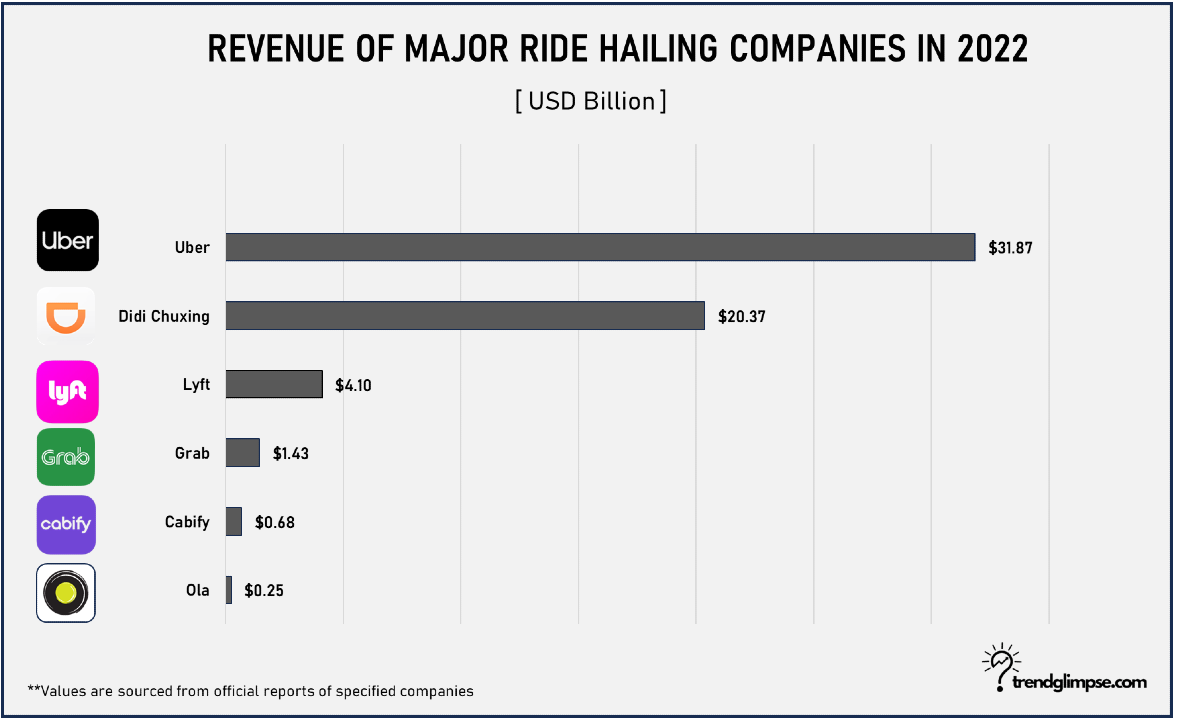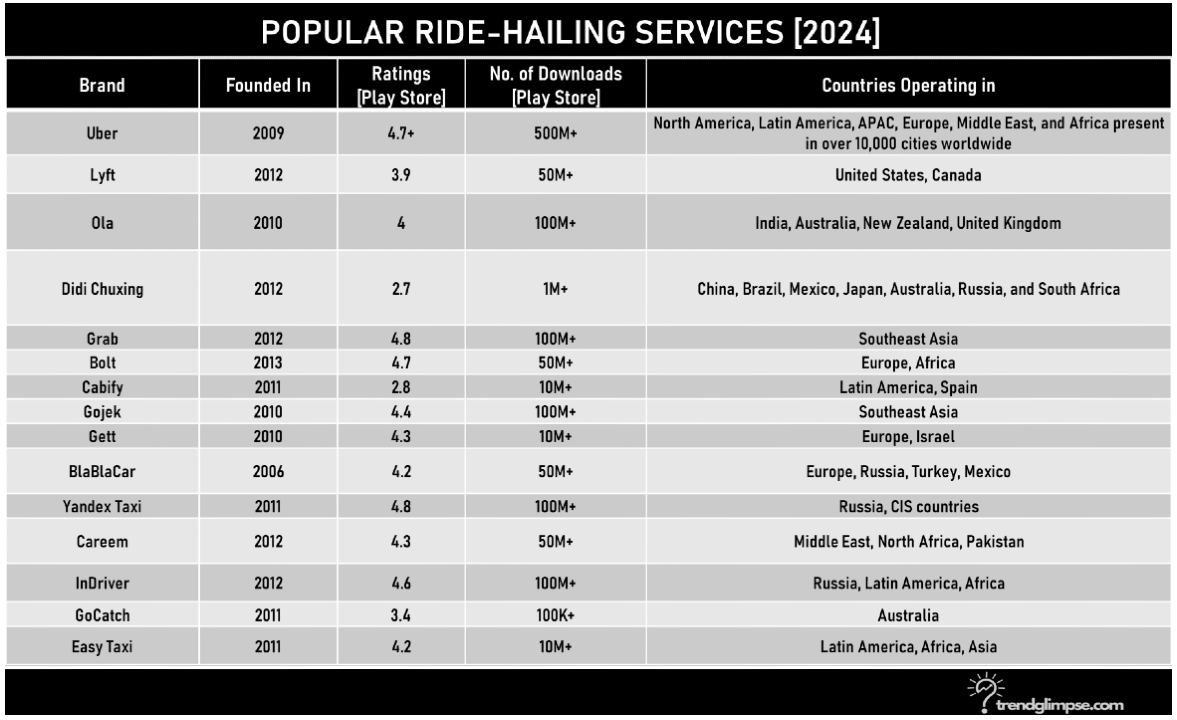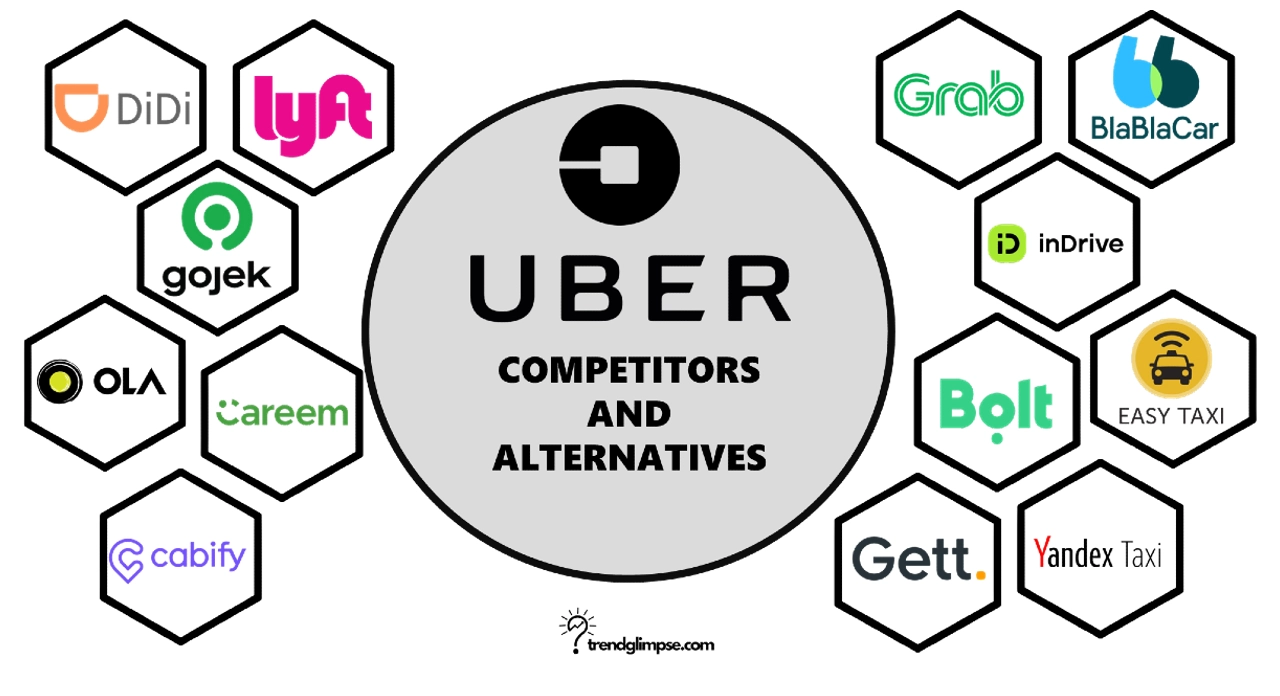An Overview of Uber
Uber has certainly shaken up the transportation industry since it was founded in 2009. The app-based ridesharing company quickly became popular by allowing anyone with a car to become a driver and provide rides to passengers through the app. What really made Uber stand out was its convenience – with just a few taps you could request a ride that would arrive within minutes.

Globally, Uber now faces stiff competition. The biggest threat is from Lyft which has rapidly expanded to challenge Uber across the country. Other Uber Competitors and Alternatives like Grab, Ola, and Didi Chuxing have huge footprints internationally.
In this article we’ll have a look at the uber’s competitors and alternatives –
Lyft
Lyft is Uber’s main competitor in the United States ridesharing market. Founded in 2012, Lyft operates exclusively within the United States. Lyft offers the same core ride-hailing capabilities as Uber, allowing users to book and pay for rides through a smartphone app. Shifting its structure, Lyft has actively pursued a distinctive brand identity, centering its focus on social consciousness, values, and active community engagement.
To meet diverse needs, Lyft provides a range of ride models –
- Standard Lyft rides
- XL rides for up to 5 passengers
- Luxury ride types such as Extra Comfort, Black, and Black SUV
- WAV rides for wheelchair accessibility
- Lyft Assisted rides for passengers requiring assistance during pickups and drop-offs
However, in practical terms, the two offer similar services. Lyft has maintained roughly 35-40% market share in the US compared to Uber’s 60-65%. Uber’s larger driver network and brand recognition give it an edge. Although, Lyft’s focus on the US market has helped prevent Uber from establishing complete dominance domestically. While substantially smaller than Uber globally, Lyft’s entrenched position in the US makes it Uber’s most tenacious competitor in its largest market.
Ola
Ola is the leading ridesharing platform in India and a major competitor to Uber. Founded in 2010 and headquartered in Bangalore, Ola operates across over 250 cities in India as well as Australia and New Zealand. Ola offers ride-hailing for private cars as well as three-wheeled autorickshaws and motorcycle taxis. This provides affordable transportation options tailored to India’s infrastructure.
Ola caters to different travel needs by offering a variety of ride options, including –
- Ola Auto – Auto rickshaws booked through the Ola app for affordable rides.
- Ola Bike – On-demand motorcycle taxi service
- Ola Micro – Small hatchback cars for up to 3 passengers booked
- Ola Mini – Compact sedans for up to 4 passengers
- Ola Prime Play – Premium hatchbacks for up to 4 passengers
- Ola Prime Sedan – Mid-sized sedans for up to 4 passengers
- Ola Lux – Luxury sedans for up to 4 passengers
- Ola Exec – Top-end sedan service for airport transfers
India’s ridesharing market is dominated by Ola, which has over 50% market share. Uber trails behind with around 30% share. In 2022, Ola went public after integrating ridesharing into a super app that also offers food delivery, payments and other services. While India is its primary focus, Ola has also entered markets like the UK and Australia to take on Uber more directly. With strong brand recognition and an understanding of local needs, Ola makes it difficult for Uber to dominate ridesharing in the critical India market.

Didi Chuxing
Didi Chuxing is the dominant ridesharing platform in China and one of Uber’s biggest global competitors. Founded in 2012 and headquartered in Beijing, Didi operates in 16 countries but China accounts for 90% of its business. Didi offers ride-hailing, bike-sharing, taxi, food delivery, and other services through a super app with over 500 million users.
Didi Chuxing provides various ride options such as –
- Ride-hailing services: It includes Taxi-hailing service, Enterprise business ride solutions, Bike and e-bike sharing, etc
- Delivery services: DiDi Australia also offers delivery services that allow users to request deliveries
- DiDi Travel: DiDi offers a new feature called DiDi Travel, which allows drivers to offer what they want to earn and enjoy a low 10% service fee
- Delivery Services: Includes food delivery, intra-city freight, and financial services
- Co-designed ride-hailing EV: Didi Chuxing and electric vehicle maker BYD planned to launch a test batch of a co-designed vehicle for ride-hailing services.
- Neuron: Didi’s first prototype robotaxi.
- Customized vans: Didi and BYD launched their purpose-built D1 van model for ride-hailing services.
- Self-driving test fleet: DiDi Autonomous Driving teams up with Volvo Cars for self-driving test fleet.
In 2016, after an intensely competitive battle, Uber conceded defeat in China by selling its operations to Didi for an equity stake. Didi was better positioned with its domestic expertise and familiarity with Chinese regulations. Although focused on China, Didi has global ambitions, expanding into Latin America, Russia and Australia to take on Uber directly. Backed by investors like Softbank, Didi is a well-resourced threat. While Uber dominates globally, defeating Didi on its own turf in China remains an uphill challenge.
Grab
Grab is Uber’s main competitor in Southeast Asia. Founded in Malaysia in 2012, Grab operates in over 200 cities across 8 countries in Southeast Asia. Grab offers ride-hailing, food delivery, and payment services similar to Uber, but focuses specifically on the Southeast Asian market. They charge a commission of 16-25% for every ride it facilitates and takes a service fee of 25-30% from restaurants for food delivery.
Grab offers a range of ride choices, including –
- GrabCar – Everyday private cars for up to 4 passengers.
- GrabCar Plus – Premium sedans with extra legroom and professional drivers.
- GrabCar Exec – High-end luxury vehicles with professional drivers.
- GrabBike – On-demand motorcycle taxi service.
- GrabTaxi – Ability to book licensed taxis through the app.
- GrabShare – Carpooling option to share rides with others.
- GrabCoach – Fixed route shuttle bus service.
- GrabWheels – Scooter, bike, and motorbike rental.
- GrabFood – Food delivery service.
- GrabMart – Grocery and essentials delivery.
- GrabExpress – Courier delivery and logistics service.
- GrabPet – Pet transportation service.
Grab is able to cater its offerings to local tastes and habits better than Uber. For example, Grab offers cash payment options and motorcycle taxis that are popular in the region. Grab has over 5 million drivers registered on its platform. In 2018, Grab acquired Uber’s Southeast Asia business, making it the dominant player in the region. Grab reported revenue of $206 million in Q1 2022. Grab went public via SPAC in 2021. Grab’s local knowledge and scale make it difficult for Uber to compete in Southeast Asia.
You Might Also Like – HelloFresh Business Model
Bolt
Bolt is an Estonian ride-hailing company that competes with Uber in Europe and Africa. Founded in 2013, Bolt operates in over 40 countries and 200 cities worldwide. Bolt focuses on competitive pricing, taking a lower commission from drivers than Uber. This helps Bolt attract more drivers, reducing wait times and prices for riders. The company offers ride-hailing, micro-mobility like e-scooters, and food delivery.
Various ride options available at Bolt are –
- Bolt Ride – The core ride-hailing service. A variety of vehicle options from economy to premium.
- Bolt Comfort – Extra spacious vehicles with additional legroom.
- Bolt Premier – Luxury vehicles with professional drivers.
- Bolt Van – Larger vehicles for groups up to 6 passengers.
- Bolt Food: Food delivery service, available in over 80 cities across 20 countries.
- Bolt Market: Grocery delivery service.
- Bolt Electric Bikes – Bike and e-bike sharing in select markets.
- Bolt Scooter Platform: Micromobility rental service.
- Bolt for Business – Corporate ride-hailing and delivery accounts.
The company is popular in Eastern Europe but is expanding across Europe and recently launched in London. Bolt is still much smaller than Uber, completing around 10 million rides per month compared to Uber’s 5 billion per year. But Bolt’s local operations and driver-friendly commission rates make it a growing threat. Bolt is aiming to turn profitable by 2025. While Bolt isn’t yet a global giant like Uber, its growth in Europe and Africa shows it’s a formidable regional competitor.

Cabify
Cabify is a Spanish ride-hailing and delivery company that operates in Spain, Portugal, and Latin America. Founded in 2011, Cabify is one of the early ride-hailing apps launched before Uber. It operates in over 10 countries and 120 cities across Europe and Latin America. Cabify ended 2022 with results 32% higher than in 2021 globally, reaching $688 million in turnover. It has over 30 million registered users and 400,000 drivers. The company plans to triple its revenues in the next three years.
- Carbon Neutral Trips: Cabify offsets the CO₂ of all trips and provides 100% electric motorcycles and scooters for environmentally friendly travel.
- Versatile App: One app for various needs – travel, drive, ship, or receive groceries, providing convenience in one place.
- Multiple Services: Cabify offers classic chauffeur-driven cars, ASAP pickups, traditional taxis, high-end business cars, family-friendly options, large group vehicles, electric mopeds, and delivery services.
- Accessibility: EuroTaxi for users with reduced mobility and a safety button for emergencies enhance the accessibility features.
- Tailored Business Logistics: Cabify Logistics introduces a specialized line of business offering customized logistics solutions, including scheduling, storage, and last-mile distribution for businesses.
Cabify aims to differentate itself by promoting safety and accountability. It was the first ride-hailing app to perform driver background checks in Spain. Cabify also works closely with taxi companies and authorities to operate legally, unlike Uber’s more disruptive approach initially. While Cabify is smaller than Uber, its local relationships and focus on meeting regulatory requirements help it compete effectively in Spain and Latin America. Its scale and experience make Cabify a competitive threat to Uber in Southern Europe and Latin America.
Gojek
Gojek is a ride-hailing and delivery company based in Indonesia. Founded in 2010, Gojek operates primarily in Indonesia but has expanded to other Southeast Asian countries. Gojek offers ride-hailing for cars and motorcycles, food delivery, payments, and other on-demand services. As a local Indonesian company, Gojek understands the unique transportation needs of the country better than Uber.
- GoRide – Main ride-hailing service with car, motorbike, and van options.
- GoCar – Everyday cars for up to 4 passengers.
- GoCar Premium – Mid-range sedans with professional drivers.
- GoBike – On-demand motorbike taxis.
- GoSend – Courier delivery service for documents and parcels.
- GoFood – Food ordering and delivery service.
- GoMart – Grocery delivery from selected supermarkets.
- GoShop – Same-day shopping delivery service.
Gojek received $1.2 billion in March 2020 for a $10 billion valuation. It included investments from major companies, including Google, Tencent, Facebook, and PayPal. Motorcycle taxis are essential for navigating congested urban areas. Gojek’s motorcycle taxi service Go-Ride makes it a preferred option over cars. Gojek also offers unique services like massage and beauty service delivery, tailored to local demand. In 2018, Gojek acquired Uber’s Southeast Asia business after Uber struggled to compete. Gojek reported $3 billion in annual payments transactions in 2021. Although Gojek is focused on Indonesia, its local expertise and popularity make it difficult for Uber to penetrate the Indonesian market.
Gett
Gett is an Israeli ride-hailing company that operates primarily in Europe and North America. Founded in 2010, Gett serves over 100 cities worldwide. Gett differentiates itself by focusing on the corporate transportation market. Its “Gett for Business” service offers business accounts, expense management, reporting and optimization of routes for companies. Gett is the ride-hailing leader in Russia and also operates in London, New York City and other US cities.
- Ride-hailing: Gett’s core service is providing on-demand rides through their app.
- Delivery: Gett offers on-demand package and food delivery in some markets through Gett Delivery.
- Logistics: Gett provides logistics and dispatch software for companies that manage fleets of vehicles. Features include route optimization, vehicle tracking, analytics, etc.
- Events rides: Gett can provide group transportation, like shuttle services, for large events or conferences.
- Self-driving vehicles: Gett is developing self-driving vehicle technology and plans to integrate autonomous cars into their ride-hailing services in the future.
In 2018, Gett acquired Juno, an Uber competitor in New York City. Gett offers standard ride-hailing as well as options for luxury vehicles and carpooling. Although much smaller than Uber overall, Gett’s focus on business travel gives it an edge in that lucrative segment. Its partnerships with taxi companies also help it compete in regulated markets.
You Might Also Like – Nike PESTLE Analysis
BlaBlaCar
BlaBlaCar is a French long-distance ridesharing platform and competitor to Uber. Founded in 2006, BlaBlaCar connects drivers with empty seats to passengers looking to travel between cities and countries. Drivers charge passengers a fee, making it more affordable than taking the train or bus. BlaBlaCar operates in 22 countries, primarily in Europe but also Russia, India and Mexico. It has over 110 million members and facilitates over 1 million trips per quarter.
BlaBlaCar differentiates itself by focusing on long distances and building a community—passengers rate drivers and connect based on shared interests. Uber primarily does short urban trips. BlaBlaCar is the long-distance rideshare leader in Europe. Its global coverage, large membership base and focus beyond daily commuting make BlaBlaCar a competitive threat as Uber looks to expand into more transportation verticals.
Yandex Taxi
Yandex Taxi is the leading ride-hailing service in Russia and a major competitor to Uber. Launched in 2011, Yandex Taxi operates in over 20 countries but is dominant in Russia and CIS countries. Yandex offers ride-hailing, food and grocery delivery, and self-driving cars. It has a fleet of over 1 million cars. Yandex Taxi commands over 65% market share in Moscow. It offers lower fares than Uber by taking a smaller commission from drivers.
Yandex integrates ride-hailing seamlessly into its super-app that also includes search, maps, entertainment, and other services. This creates a sticky ecosystem making it hard for Uber to compete. In 2017, Uber left Russia by merging its operations into Yandex Taxi. While Yandex Taxi operates mostly in Russia/CIS, its local expertise, super-app capabilities, and large driver fleet make it difficult for Uber to re-enter this key market.
Careem
Careem is a ride-hailing app that competes with Uber primarily in the Middle East. Founded in 2012 in Dubai, Careem operates in over 100 cities in 15 countries from Morocco to Pakistan. Careem offers ride-hailing for cars, motorcycles, and three-wheeled tuk tuks, plus food and package delivery. It acquired Uber’s operations in the Middle East in 2019 for $3.1 billion.
Moreover the company aims to differentiates itself by offering culturally relevant options like women-only car services. Careem also allows cash payments to serve unbanked customers. Before selling to Uber, Careem raised over $750 million in funding. The company understands local culture and regulations better than Uber. Its brand recognition, scale, and large driver network in the Middle East make Careem a leading ride-hailing platform that is difficult for Uber to challenge in the region.
InDriver
inDriver is a ride-hailing app competing with Uber using peer-to-peer ride pricing. Founded in Russia in 2013, inDriver lets passengers name their fare and nearby drivers can accept or negotiate it, unlike Uber’s fixed pricing. This often results in cheaper rides. inDriver operates in over 700 cities and across 47 countries including the US, Latin America, Europe and Africa. inDriver doesn’t take a commission from drivers, only charging passengers a small convenience fee.
This increases earnings for drivers. inDriver offers many of the same services as Uber including ride-hailing, food delivery and package delivery. inDriver’s lower fares and flexible pricing make it attractive to price-sensitive passengers and drivers. While smaller than Uber, inDriver’s pricing model and focus on emerging markets makes it a competitive threat as Uber targets global growth, especially in developing countries.
GoCatch
GoCatch is an Australian rideshare company competing with Uber primarily in the Sydney and Melbourne markets. Founded in 2011, GoCatch has over 60,000 drivers on its platform and focuses exclusively on the Australian market. GoCatch offers the standard ride-hailing and ride-sharing services similar to Uber, enabling passengers to book and pay for rides through a mobile app.
However, GoCatch aims to differentiate itself by taking a smaller 10% commission from drivers, compared to Uber’s 25%. This helps GoCatch attract more drivers through higher earnings. GoCatch also integrates closely with existing Australian taxi services rather than disrupting them. While Uber dominates rideshare globally, GoCatch’s local-focused strategy tailored to Australian taxi regulations helps it compete effectively against Uber’s more aggressive approach in its home country.
Easy Taxi
Easy Taxi is a ride-hailing company that competes with Uber primarily in Latin America and Africa. Founded in 2011, Easy Taxi operates in over 30 countries across the two continents. Easy Taxi works like other ride-hailing apps, allowing passengers to book and pay for rides through a smartphone.
That is to say, Easy Taxi focused on emerging markets and tailored its offerings to local conditions earlier than Uber. For example, Easy Taxi integrated with existing taxi fleets and supported cash payments in underbanked markets. Ultimately, In 2017, Easy Taxi merged with another Uber competitor, 99Taxis, to boost its scale in Latin America. While significantly smaller than Uber overall, Easy Taxi’s local knowledge and partnerships in emerging markets make it a formidable competitor against Uber’s standardized global playbook as Uber tries to expand worldwide.
Conclusion
It’s been fascinating to see the ridesharing industry explode and all the Uber Competitors and Alternatives that have emerged.
When Uber first showed up, it really had the market to itself. Smaller Uber Competitors and Alternatives tried to compete locally but couldn’t match Uber’s scale and dominance.
But now, powerful global players like Lyft, Ola, Didi Chuxing and others are going head to head with Uber. These Uber Competitors and Alternatives have used big investments and aggressive expansion to build impressive footprints.
Many of these competitors are using similar tactics to try to beat Uber – providing better driver incentives and a larger cut of fares. Time will tell if these strategies pay off in the long run by locking in driver loyalty.
While Uber is still the clear leader, its position isn’t nearly as unassailable as it used to be. The Uber Competitors and Alternatives are nipping at its heels on all fronts. And they have the resources and know-how to take the fight to Uber.

I have always been fascinated by the inner workings of companies and industries. So I decided to study business to explore it more. My goal is to take all my research and turn it into cool stories that give people a better understanding of the business world.

